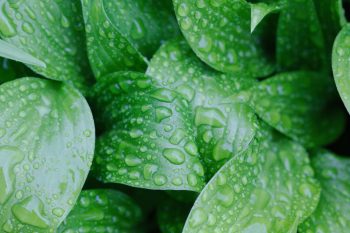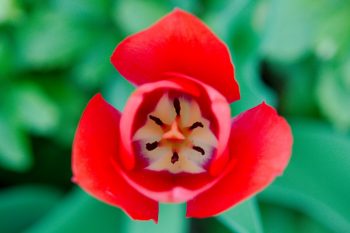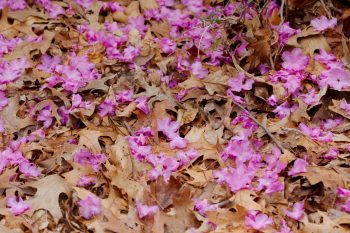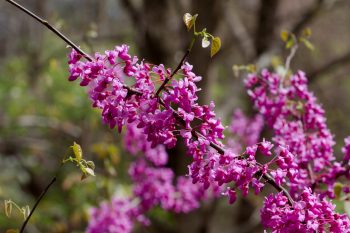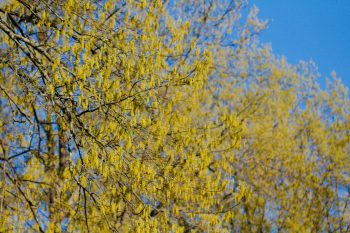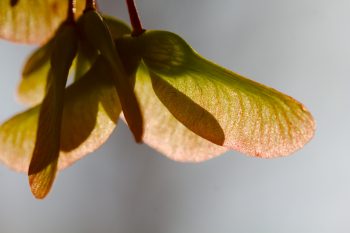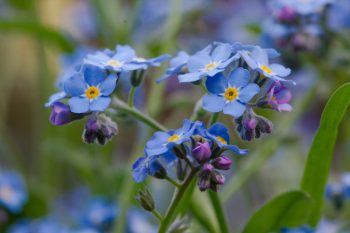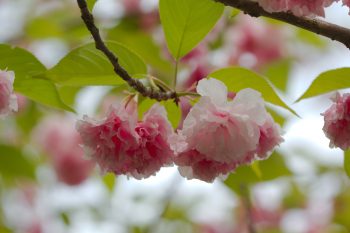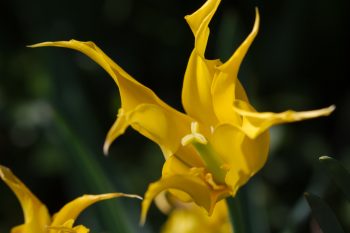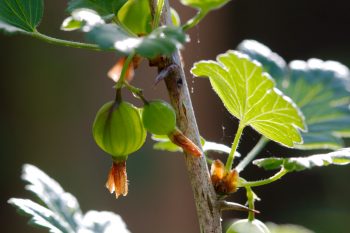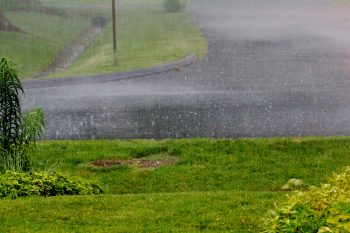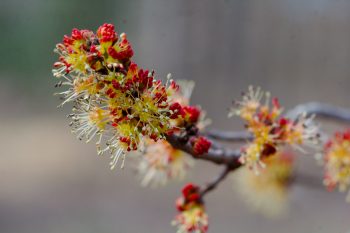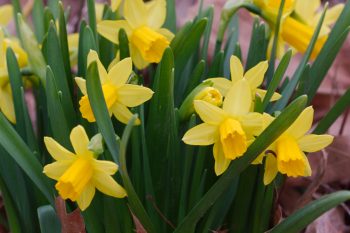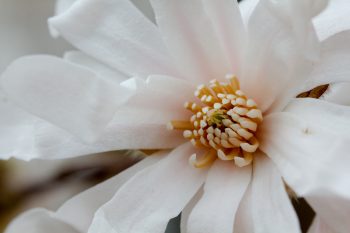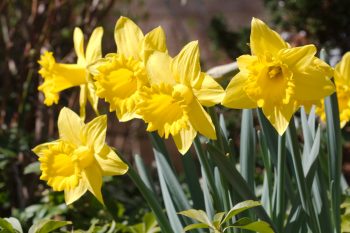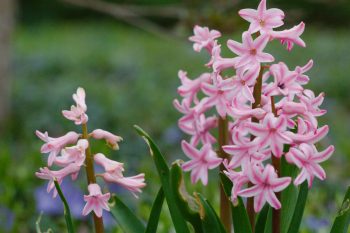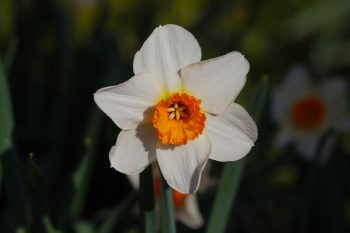It rained today and there was water on the the plants in the yard. The forecast was for a chance of rain all through the weekend but (as I write this on Monday) it turned out to be fairly nice. I really love the pattern of water on plant leaves, in any case, and these fresh, young leaves of hosta in a pot on our patio are such a beautiful, vivid green I couldn’t resist them. I also took pictures of water on Columbine flowers and leave and on a really pretty bracket fungus that was growing on the decaying roots of an oak tree that the county removed a few years ago.
Tagged With: Spring
Tulip ‘Van Eijk’
In the fall of 2009 and again in 2010 I bought a pretty good number of bulbs from McClure and Zimmerman (https://www.mzbulb.com/). In each of those orders they threw in five tulip of the variety ‘Van Eijk’. There are still ten plants growing where I planted them although we only have six blooms this year. Tulips are not terribly long-lived plants, certainly not in our area, anyway, so the fact that these are still blooming after 8 or nine years is pretty good. They’re quite bright and a sea of them would be more impressive than the six I have, of course. In general, though, I’m more a fan of daffodils, which seem to live forever and form large clumps over time.
Rhododendron Petals
There are still a few daffodils blooming at the Stadtman Preserve but most of them are finished. The P.J.M. Rhododendrons are also a little past their peak and are dropping flowers on the ground around them, as you can see here. There are pink and white deciduous azaleas blooming now and there are spring beauties (Claytonia virginica) by the hundreds. There are some trillium coming up and a few with buds but none blooming yet. There are also ferns coming up in a few places. Spring always seems to go by too fast, but it’s sure nice while its here.
Eastern Redbud (Cercis canadensis)
I took a break and went out into the woods today to take a few pictures. The eastern redbuds (Cercis canadensis) are blooming and they really are something. This is the native eastern redbud, which is similar to but distinct from the Judas tree or Mediterranean redbud (C. siliquastrum), native to the Eastern Mediterranean. They are both admired for their rose-purple flowers which are borne on bare branches in early spring (i.e. now) and before the foliage emerges.
Flowering Oaks
There are trees we generally think of as flowering trees, such as dogwoods, cherries, and crab apples. But of course, most non-coniferous trees bloom, even if that’s not why we grow them. Out neighborhood has street trees planted pretty much throughout with different streets and different sections having different tree species but mostly planted with the neighborhood was developed in the late 1960s. Our area has mostly red oaks and at nearly 50 years old, they are generally pretty good size. Oaks are among those not usually grown for their showy flowers. Nevertheless, when they are in full bloom, particularly on a clear day in contrast with the blue sky, they are quite dramatic. Of course, the pollen is everywhere and if you have allergies, you aren’t enjoying this. But it can be beautiful.
Tulips
In the front of my office building there are a few flower beds including one raised bed with a bunch of tulips growing in it. They are bright orange and red and really striking. I usually go into the building through the back door so I hadn’t noticed them but my friend, Corina, said I should take a look. I did and she was right. Naturally when she said take a look, she meant take some pictures, so I did that, too. It was late in the day and they were in the shade of the building, making it a little harder, exposure wise, but I really love their colors.
Maple Samaras
It’s that time of the year when the maple trees let loose thousands upon thousands of “helicopters” (a.k.a. samaras). They’ll be thick on the lawn and patio and front walk. Not as thick as they once were, because we have fewer maple trees than we did, but still quite a lot. Then they will start growing. In the lawn, the first time the grass is cut, they’ll be taken care of. In the garden beds they need to be pulled up.
Myosotis sylvatica (Woodland Forget-me-not)
The forget-me-nots (Myosotis sylvatica) are in full bloom in our garden. They self-seed and many of them are growing out in the grass. Cathy has dug a few up to replant in the garden beds where they won’t get mowed over. We both really love the powder blue of the forget-me-nots and are happy when the start to bloom. The buds are purple and the flowers, as they start to open, turn from a pinkish purple to the pure blue of the fully-formed flowers. You can see one transitioning at the right in this photo. The yellow “eye” in the center of each bloom turns white as the flower ages.
Double Flowering Cherry
The regular flowering cherries are pretty much finished but there are these double-flowered cherries and they still look wonderful. Not only are they a considerably stronger pink than the single variety but the flowers are much larger, measuring a few inches across. They are somewhat hard to photograph because the best views of the flowers are had looking up at them and when they are backlit by a bright sky, they tend to go quite dark. This one turned out pretty well.
Tulipa acuminata
The fireflame tulips (Tulipa acuminata) are coming into bloom. These interesting tulips are listed as species but they are not actually known in the wild and are probably some very old hybrid whose origin is lost in the mists of time. Either way, they are quite beautiful, with the pointed petals. They generally have mostly red petals with yellow towards the base but this variety, from McLure and Zimmerman, are almost entirely yellow with a little green running down the spine of the petals. Every year I wonder if they will come up and so far, they’ve not let me down.
Lily of the Valley
The lily of the valley (Convallaria majalis) is starting to bloom. This is a great, little ground cover once it gets itself established. That can take a little while and they aren’t cheap when you buy them from the garden center a few pips at a time. They also have a tendency to “migrate” in the garden. In our back yard they are around the two smaller maple trees that we still have. Over the time we’ve been here they have expanded and died out in the central part of the bed. I wish you could make it “turn around” and head in the other direction but short of digging it up and physically turning it around, that’s not really possible.
The flowers don’t last very long but while they are blooming they are really pretty. Note that all parts of the plant are poisonous, containing cardiac glycosides, so don’t try to use them as a salad green. I don’t think that’s something I’d have thought to try anyway.
Gooseberry
This gooseberry plant (Ribes uva-crispa) was originally put in by Albert in their yard. After he passed away, Brady said I could have it and it’s growing in the back of our garden. It blooms fairly early for a fruit bush and the fruit ripens fairly quickly. I really enjoy gooseberry jam, as I like most things of a tart nature. One thing to watch for when pruning and picking the fruit from a gooseberry bush is the thorns. They are quite sharp and vicious. There used to be a federal ban on growing gooseberry and other Ribes species but that was lifted in 1966. A few states still prohibit the growth of some or all Ribes species but they are all legally grown in Maryland.
Hail Storm
We don’t get hail all that often. When we do, the hail is generally small and the storm is generally brief. In today’s storm the hail was pretty large at first, with hail at least a half inch across and some more like three quarters or more. That didn’t last long and then the hail was more pea size, which is what you can see in this photo. That lasted a bit longer and then it was just rain after that, really coming down for a while. I enjoy storms, particularly since we live in relative safety and comfort. I wouldn’t have liked being out in this, though.
Maple Blossoms
We happened to be in northern Virginia this afternoon to meet some friends for brunch. We got there a little early so we walked in a park near the restaurant and I took some pictures of three different plants that are in bloom. First, and seen here, are maple blossoms. I think this is a silver maple (Acer saccharinum) but I didn’t take the time to identify it carefully. I’m pretty sure it isn’t red maple (Acer rubrum) but it could be a sugar maple (Acer saccharum) or a number of other species. It’s a bit early even for the early trees to be blooming but it’s been such a mild winter so far, I’m not terribly surprised. It may get cold yet, of course. It’s still only mid November.
‘Tete-A-Tete’ Daffodils
Daffodils are starting to bloom all over. The early varieties, particularly in warm locations, have been in bloom for a week or so. These are our first to get fully out. They are called ‘Tete-A-Tete’ and they are a nice, little, clump-forming variety that I really like. We have them in a few places and they are very happy, blooming as the others are still forming buds. They are only about 8 to 10 inches tall, so not suited for growing in with too much ground cover. So, in the pachysandra we have taller varieties, like ‘Arkle’ which is big and bold but blooms a little later.
Star Magnolia
The star magnolia (Magnolia stellata) is a really nice flowering tree, relatively slow growing but eventually getting up to about 20 feet tall and nearly as wide. It flowers rather early in the spring and it’s not uncommon, at least here, for the blooms to be killed by a late frost. We’ve been spared that this year and they are blooming all over right now. The generally later saucer magnolia (Magnolia × soulangeana) is starting to bloom around the neighborhood, also. There are some cherries blooming and the daffodils are coming out in great numbers. It’s a pretty time of year.
Daffodil ‘Arkle’
As mentioned yesterday, the daffodils are really starting to come out in great numbers. This is one called ‘Arkle’ and it’s a big, bold, beautiful yellow flowered variety. I planted these back in 2014 and they are very well established. Daffodils are long lived and form nice clumps. Where you put one bulb, you will eventually have a group of them, each putting up flowers, so the longer they are in the ground, the better. Others that were planted more recently, a variety called ‘Marieke’ that has similar but slightly larger flowers is still putting up only 3 or 4 blooms per clump. But they should continue to get better each year.
Pink Hyacinths
The hyacinths are in bloom. These were planted pretty soon after we moved in and they didn’t really thrive but every year they come up. There are three little clumps of them, one purple, one white, and this pink one. They are growing in a bed of Vinca minor, also known as periwinkle, and lily of the valley (Convallaria majalis). You can see a little of the periwinkle color in the background. It’s nice to see them out our kitchen door. I’m not a fan of their fragrance, so I like they more at a distance than close up.
Daffodil
This is one of my unknown daffodils. The fall when we moved into our house I took some family pictures for some friends and they gave me a bunch of bulbs as a thank you present. They either were not marked or, more likely, I didn’t write down the names, but they bloom every year. This is one of them. There is another, very double daffodil as well and the hyacinths that I posted a picture of a couple days ago. The daffodils are between our front walk and the house and put on a really good show.
Spiraea prunifolia
Our spiraea is in bloom and it’s really pretty as a background plant. It’s flowers are small but borne in a profusion of white. There are little bits of green in the flowers, but that can really only be seen close up. Spiraea prunifolia, bridal wreath spiraea, is a native of China, Japan, Korea, and Taiwan and has been introduced in much of eastern North America. Interestingly, this double-flowered plant has the species name while the single-flowered variety, discovered later, is classified as a variety or form of the species. The name of the genus Spiraea comes from the Greek word speira meaning wreath.

